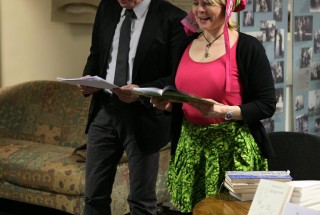BLOG
LATEST NEWS
The poems by Heli Laaksonen go around Latvian towns and in some ports, there've been special poemcows Guest post by Ingmāra Balode
15.01.2013

Actually, she has already been captured and kidnapped, wrapped in the thick air of a few seaside towns and in all the capitals of the capital (th. is Riga) - since the book by Heli Laaksonen was translated into Latvian, she's ours. As simple as it is. The translator - Guntars Godiņš - has accomplished the mission of taking Heli in a book-opening tour in Salacgrīva, Madona, Jēkabpils, Rīga (mentioned above), and Ventspils (the famous blue cows of the region - almost mentioned above).
I happened to be in the final reading, at Ventspils Main Library. Heli and Guntars were warmly welcomed by the local public, and fulfilled almost two good evening hours -- poeming and talking, commenting and pointing out, counting birchtrees and sometimes even cows. The book, "Kad gos smei", published by Mansards, has been around, emerging and disappearing from bookstores for some weeks already, but, as I noticed, most of the port-town inhabints who were present in the reading, used the option to get it straight from the author's hands, and to exchange with Heli a few words in their local dialect, called also tāmniek mēle (the tāmnieki tongue). All the Heli's poems in translation has to be blamed in a fact, that people are convinced that this Finnish poet speaks fluent Latvian -- and particulary, their sea-shore-version of it.
During the Ventspils event, also Līga Reitere, one of the native-speakers of west-Kurzeme dialect and also a teacher of the local Craft's house (Amatu māja), gave a touching speech on the necessity of writing in dialects, expressing oneself exactly as one's heart tells, and compared the dialect in which Guntars had translated Heli's poems, whith the very much alike, but still slightly differing Ventspils version of the same Liiv people influence. They, the Liiv nation, used to live along the coastline and give names to everything connected with the sea and fishing, and occasionally also some more earthy-things (a poetry-rider Valts Ernštreits could tell more about them, as he belongs to the few Liiv language speakers, and scholars). As Heli also claimed, one's heart happens to speak in a grandmother's dialect; Heli even showed the picture of her grandmother, so everyone could know she is not making up metaphors.
Sitting in the Ventspils library and also receiving some news and messages from people in Riga and other places where the "Kad gos smei" got opened and opened again, I clearly saw that Heli opens her readers' hearts, and minds of her conversation mates, with the genuine warmth of the language, and makes them also respond with a smile. She is brave enough to be simple, and actually, so I dare to think, it is one of the most important braveries these days.
The fact we, Latvians, have taken her poetry completely to ourselves, has to be proved by a casual situation... After the reading, I joined Heli and her company in a walk along the streets of Ventspils -- one of the organisers of the poetry ride, Guntars, is famous for not being still, not for a second: when he's not translating, he has to run, to drive, to drill the ice for fishing or, at least, to laugh -- so, before they made their way back to Rig, we rushed around a bit in Ventspils. While Heli was doing photos of some old corridor with a wooden staircase in a bluish house (with no blue cows around, but still rather pretty old building), I noticed something which the artist of Heli's book - Aija Zariņa - could have missed including in the book. It was an illustration to a Heli's poem I have not read but can imagine being written. A very situationally-Heli-like picture. On a snowy street, on two white rows, stood an old, rusty baby-carriage, and on it, there was a huge pile of wood for some stove. Heli came out of the blue house and immediatelly run to picture the wod-transporter, as if the abandoned carriage could take its pace and leave in any minute, to warm some of the tiny houses along Skroderu street, which once belonged to tailors, as the street sign said.








Leave a comment